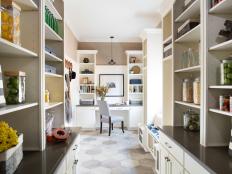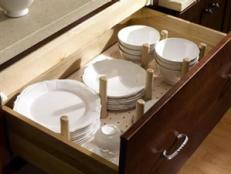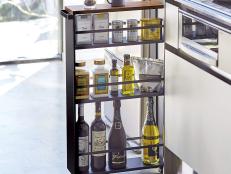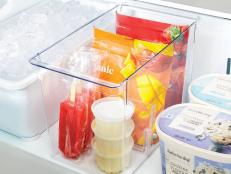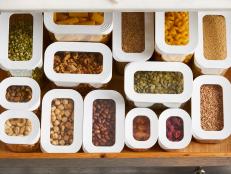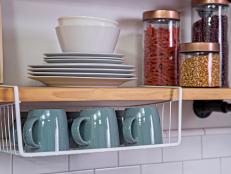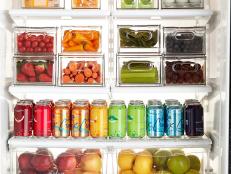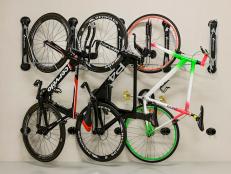9 Ways to Make Your Kitchen Work Harder — Without Remodeling
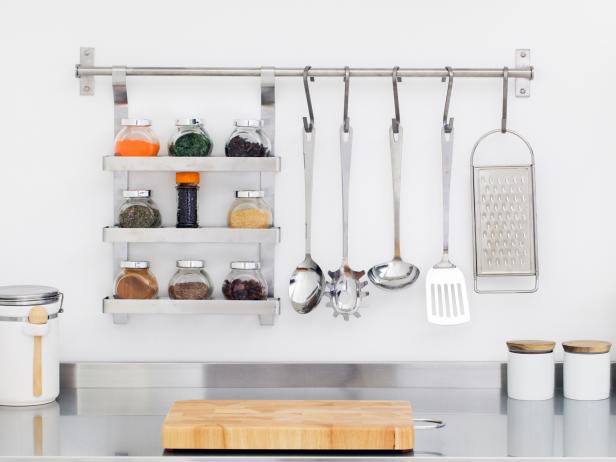
©iStockphoto.com/aluxum
Frustrated with your kitchen’s limited space or less-than-optimal design? It’s still possible to maximize function with clever storage and smart tool choices. For guidance, we asked restaurateur and Iron Chef judge Elizabeth Blau, owner of Las Vegas restaurant Honey Salt, and Kaci and Robert Lyford, owners of the McKinney, Texas, antique shop Patina Green Home and Market, where chef Robert prepares meals in a makeshift kitchen using only a small oven and limited appliances.
Here are their top tips for a hard-working kitchen:
1) Mind the action triangle. “I like to keep all of my pots and pans and tools centrally located around the stovetop, sink and refrigerator — the action triangle of the kitchen,” Blau says. “We have deep cabinets underneath our range where we keep all our pots and pans.”
2) Keep staples within arm’s reach. “Store herbs and spices in glass jars on open shelving near the cooktop,” Lyford says. “It’s easily accessible for the chef and beautiful to look at.” His must-haves are salts (sea salt, kosher salt and finishing salts), black peppercorn, dill seed, smoked paprika and mustard seed. Blau agrees: her husband, Honey Salt executive chef Kim Canteenwalla, always keeps a pepper mill, a few kinds of salt, good olive oil and vinegar next to the stove.
3) Use open storage. “I love cool containers and jars,” Blau says. “They’re an awesome way to add some color and fun to the kitchen. Pasta, flour, grains and coffee are easy to find if they’re organized and well labeled, and they still look great on display. When I lived in New York City and had no cabinet space, this was a total lifesaver for me.”
4) Simplify serveware. The Lyfords recommend owning just one set of dinnerware — white, which complements any food and any occasion and looks great on open shelving. Also, they say, choose a cutting board that’s both functional and beautiful so it can remain out on the counter; use one side for cutting and the other for serving.
5) Pare down your tools. “Throw away all the trendy gadgets — including all ‘As Seen on TV’ choppers, slicers and dicers — and learn how to use a chef's knife,” Lyford says. “For example, the side of a knife can be used to smash garlic, replacing a garlic press.” (If you can’t kick the gadget habit, Blau — who admits she loves them — suggests keeping them stored in their boxes with all their parts rather than dumped into a drawer.)
6) Choose items that do double — or even triple — duty. The Lyfords like Mason jars because they can serve as both drinking glasses and food storage, allowing you to get rid of bulky plastic containers. And Chef Robert’s favorite multitasker? A Vitamix. “It not only serves as a juicer, but also eliminates the need for an extra blender, mixer and food processor,” he says.
7) Embrace lists and apps. “We keep a constant grocery list going on a pad right next to the fridge,” Blau says, and she suggests focusing on what you’re about to be out of rather than just writing down what you’ve emptied. “There’s nothing worse than needing a cup of milk for a recipe and you only have the bottom of the bottle,” she points out. Cornell University’s FoodKeeper app can help you keep track of when your groceries are nearing the end of their shelf life and need to be replaced — plus it offers smart tips for food storage.
8) Keep like with like. For optimum efficiency, Lyford delegates one drawer to baking tools (measuring cups, measuring spoons, spatulas), one to cutting and chopping (knives, graters, zesters) and one near the cooktop for cooking essentials (spoons, spatulas, thermometers). In the pantry, he keeps all dry ingredients together, all oils, all vinegars and so on. Storing items this way saves space, minimizes cooking time, and keeps you on top of what supplies you need.
9) Buy fresh. Lyford says this is the most important tip of all: buy fresh ingredients every day and cook with them! (And decorate with them too: you can use a vaseful of herbs as both cutting garden and centerpiece.) You’ll face fewer storage dilemmas — plus you’ll be healthier and happier.






